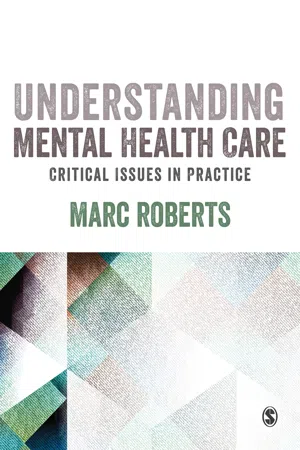Psychology
Treatment of Psychological Disorders
The treatment of psychological disorders involves various therapeutic approaches aimed at alleviating symptoms and improving overall mental well-being. These approaches may include psychotherapy, medication, and lifestyle changes. The goal is to address the underlying causes of the disorder and help individuals develop coping strategies to manage their symptoms effectively.
Written by Perlego with AI-assistance
Related key terms
5 Key excerpts on "Treatment of Psychological Disorders"
- eBook - ePub
- Matt Field, Sam Cartwright-Hatton(Authors)
- 2015(Publication Date)
- SAGE Publications Ltd(Publisher)
2 How are Psychological Disorders Treated?General introduction
Mental health professionals treat the symptoms of psychological disorders in a multitude of ways. This chapter will outline some of the most common ways in which they work. We will begin with a look at the debate surrounding the use of medication versus psychological techniques. After this cursory overview of the medical approach, we will then focus on approaches that are taken by psychologists (well this is a psychology book, after all). We will discuss preventative approaches, which have become an increasing focus in recent years (although still not nearly enough), and also discuss treatment approaches that are used when symptoms are already present. Within both prevention and treatment work there are many ways of working. Psychologists may work with individual clients or with groups. They may use a manual-based ‘package’, which is applied to the client with a minimum of tailoring, or they may use the gold-standard, formulation-based approach which is custom-built for each client. Psychologists also work from a number of theoretical perspectives, including cognitive-behavioural and psychodynamic. They may specialise in the treatment not just of adults, but also of children and adolescents, people with learning disabilities, older adults, and other specialist groups.This chapter will give a brief introduction to all of these approaches, but thenceforth both this chapter and the rest of the book will give most attention to what typically happens in clinics (as opposed to research trials). This is the individual treatment of one individual, using a selection of techniques that are hand-picked for that client, based on a thorough assessment of their needs. Because the bulk of the scientific evidence base is devoted to cognitive-behavioural theories and treatments, it is these that we will focus on in the rest of the book. Although there is now a growing literature on the treatment of children, families, couples, people with learning disabilities and older adults (amongst others), this chapter, and most of those that follow, will focus largely on the treatment of individual, non-disabled adults. We will also give some thought as to how researchers evaluate the usefulness of psychological therapies. Finally, we will examine the ethical framework within which all psychologists are expected to work. - Amy E. Wenzel(Author)
- 2017(Publication Date)
- SAGE Publications, Inc(Publisher)
Psychotherapy is one of the most important functions of clinical psychologists and a prominent feature of the study of abnormal behavior. Psychology as a science studies topics such as perception, learning, memory, thinking, and social behavior and focuses on those interacting biological, behavioral, and cognitive processes that produce human psychological functioning. As an applied science in the health care domain, clinical psychology attends to those processes in developing and applying treatments for the patterns of signs and symptoms associated with mental health disorders.Medical interventions also play an important part in the treatment of mental health disorders, and clinical psychologists typically obtain their psychotherapy clients’ authorization to contact and stay in touch with their other health care providers so as to be alert to pertinent physical health issues and to be familiar with clients’ regimens of prescribed medication. In their role as psychotherapists, clinical psychologists usually see their clients more often than other providers do and are in a position to monitor medication side effects and clients’ fidelity to dosage and scheduling protocols. In some jurisdictions in the United States, psychologists with specialized additional training are licensed to prescribe some of the medications used in mental health treatment.Traditions and Orientations in Psychotherapy
In 1600, John Downame, a puritan minister in London, described the treatment of irrational anger by “spiritual physicke,” a form of counseling in which he tactfully accepted clients’ perspectives on life’s injustices and met their heated outbursts with what he described as silence, soft and mild answers, wholesome counsel, and good admonitions. Drawing from the ancient theory of humors, Downame believed that anger arose from an excess of yellow bile in the body and that treatment should be prescribed from the words of the Holy Scriptures. This early form of mental health treatment cited biological factors as the cause and psychological intervention as the treatment of a common and distressing disorder. Despite disagreements about causes and cures, many of today’s psychotherapists might recognize in Downame a kindred spirit who helped his clients take new perspectives on their problems and learn to make beneficial changes in their thoughts, feelings, and behavior.- eBook - ePub
Gender
Psychological Perspectives, Seventh Edition
- Linda Brannon(Author)
- 2016(Publication Date)
- Routledge(Publisher)
Mental disorders and seeking treatment carry a stigma that is more severe for men but also affects women. A study that included people from 16 countries confirmed this worldwide bias (Pescosolido, Medina, Martin, & Long, 2013). Although people in these countries recognized the disorders, believed that the disorders were neurologically based, and endorsed seeking therapy, they also expressed prejudices against people whose behaviors showed symptoms of depression or schizophrenia. These prejudices included doubting the ability of people with these disorders to hold responsible positions or care for children as well as fearing their tendency to harm themselves. The belief in the benefits of therapy is well founded; most people who seek therapy benefit and are satisfied with the outcome. The problem is getting people into treatment, especially men. Those who take the step toward getting help have a variety of choices.Approaches to Therapy
Throughout the history of therapy, the approach to treatment has been tied to the conceptualization of the source of problems. During the 19th and early 20th centuries, medicine became the model for understanding mental disorders, and the view developed that such problems were the result of problems in mental functioning. Therapies for the treatment of mental disorders arose and became part of psychiatry and psychology.Psychoanalysis
Sigmund Freud developed a system of therapy that has influenced treatment as well as contemporary thinking about mental disorders. Psychoanalysis is a talk-based approach to psychotherapy that fits into Freud’s comprehensive theory of personality development and functioning. (Chapter 5 presents the Freudian approach to personality development.) Freud believed that psychological problems develop when people are incapable of dealing with problems and use repression - Marc Roberts(Author)
- 2018(Publication Date)
- SAGE Publications Ltd(Publisher)
The purpose of this chapter is therefore to introduce you to a variety of critical issues surrounding the use of psychological therapies in contemporary mental health care. While a diversity of such interventions are used to respond to mental distress, the chapter will begin by considering their effectiveness and whether they produce beneficial outcomes for those who receive and engage with them. In the context of the dominance of some forms of psychological intervention, we shall then consider if any one specific form of therapy is more effective than any other, as well as the way in which the quality of the therapeutic relationship, and the variety of relational factors that comprise that relationship, can influence this effectiveness. Moreover, despite the diverse range of available psychological therapies, many of them can be understood as possessing an individualistic orientation in so far they seek to facilitate change ‘within’ the individual. This chapter will therefore move on to discuss the social and political implications of understanding and responding to mental distress in terms of this individualistic orientation and, in particular, its potential limitations. Finally, in contrast to the individualistic focus of various psychological therapies, we shall examine a variety of emerging initiatives, both within and beyond the mental health system, that can be understood as being consistent with the field of practice that is known as community psychology. In particular, we shall consider the way in which community psychology interventions can be employed to understand and respond to the manner in which a variety of social and material conditions can contribute to the emergence and maintenance of mental distress.Activity 5.1 Team working
A diverse range of psychological interventions are used in contemporary mental health care and it can be a challenge making sense of that diversity. A common approach, as shown in Table 5.1- eBook - ePub
Visions in Psychotherapy Research and Practice
Reflections from the Presidents of the Society for Psychotherapy Research
- Bernhard Strauss, Jacques P. Barber, Louis Castonguay(Authors)
- 2015(Publication Date)
- Routledge(Publisher)
Psychotherapy research concerning the personality disorders is in its infancy. For psychotherapy research in this area to stay in the mainstream, it must be infused with information from the fields of personality, developmental psychology, and psychopathology and neurocognitive science. The DSM diagnostic system is insufficient to guide the treatment of personality disorders, because personality dysfunction is not synonymous with the lists of criteria. Treatments must be differentiated and multifaceted, respecting subgroups of patients with severe personality disorders. Advances in neurobiology, laboratory tasks, and interview techniques will assist in the measurement of personality organization and identification of subgroups of patients for more refined treatments. A focus on the human functions that need modification and change will bring attention to the mechanisms of change in psychotherapy, which, in turn, will inform the essential features of psychotherapeutic intervention. To be truly humane, treatments must go beyond symptom relief, introducing the patient to fruitful relations and productive work. The era of schools of psychotherapy will be superseded by focus on the ways in which treatments provide not only alleviation of symptoms but also the resumption of individual development.Commentary
Conceptualization and Treatment of Personality Disorders: 2005 to the Present
My 2005 SPR Presidential Address was focused on various aspects of personality disorder (especially, borderline personality disorder) theory and research at that time. This update explores subsequent developments in our understanding of personality disorders and treatment with special emphasis on borderline personality disorder (BPD).Personality and Personality Disorders
The theoretical description of the personality disorders remains relatively isolated from the understanding of personality in academic psychology. This disjunction in traditions has left the field of personality disorders with partial theories of the personality pathology that need advancement and amplification, both on the theoretical and empirical levels (Lenzenweger & Clarkin, 2005).One marker of the developing understanding of the personality disorders is the evolution of the DSM approach to the personality disorders. The re-evaluation of the DSM-IV diagnostic system in preparation for the DSM-5 has emphasized the limitations of a categorical system and an appreciation of the underlying biological systems that form important domains of pathology that are best captured in dimensions (Hyman, 2011). One aspect of academic psychology that was proposed for the description of the personality disorders in DSM-5 was the utilization of trait theory. Proponents of trait theory emphasize the continuity between normal personality and personality disorder, and the dimensional nature of traits (Clark, 2007). In contrast to a trait approach to the personality disorders, others focus on the clinical usefulness of functioning (Westen, 2006), the organizational structure of the personality which a list of traits does not capture (Kernberg & Caligor, 2005), the clinical utility of identifiable prototypic personality disorder types (Shedler & Westen, 2010), and the research these types have accumulated, such as that on BPD.
Learn about this page
Index pages curate the most relevant extracts from our library of academic textbooks. They’ve been created using an in-house natural language model (NLM), each adding context and meaning to key research topics.




